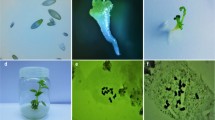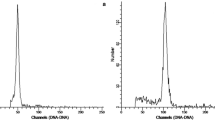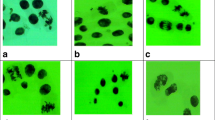Abstract
Dinitroanilines represent a class of compounds that are widely used in herbicide formulations as they depolymerise plant microtubles, causing chromosome doubling. The potential of microtubule depolymerising herbicides trifluralin, oryzalin, and amiprophosmethyl (APM) for in vitro chromosome doubling of Rosa was studied. Five concentrations (0, 3, 6, 12 and 24 μM) and three exposure periods (12, 24 and 48 h) for each of the compounds were compared. Oryzalin, trifluralin and APM were not significantly different in their ability to induce chromosome doubling of R. hybrida cv Iceberg. At concentration of 6 μM and exposure period of 24 h, chromosome doubling of R. hybrida cv Iceberg was not significantly different with each of the polyplodising agents. At higher concentration (24 μM) and longer exposure period (48 h), 66.7% and 62.5% chromosome doubling was achieved with APM and trifluralin, respectively. However, the application of 6 μM oryzalin to R. persica (2n = 2x), R. hybrida cv Iceberg (2n = 3x) and R. hybrida cv Akito (2n = 4x), resulted in 60.0%, 6.3% and 0% chromosome doubling, respectively, which suggest that chromosome doubling is genotype dependent and plants with lower ploidy level have a higher propensity for chromosome doubling. Flow cytometry results at 18 and 24 weeks after herbicide treatment, indicated that the best time to test the treated plants was after 24 weeks.



Similar content being viewed by others
References
Agayev YM (1998) Advanced squash methods for investigation of plant chromosomes. In: Fourth Iranian Congress of Crop Production and Breeding Sciences, Aug 25–27 1996, Esfehan University of Tech, Esfehan, 1–20
Bartels PG, Hilton JL (1973) Comparison of trifluralin, oryzalin, pronamide, propham and colchicine treatments on microtubules. Pest Biochem Physiol 3:462–472
Basye RE (1990) An amphidiploid of Rosa banksiae and Rosa laevigata induced by colchicines. Amer Rose Ann 75:83–87
Bennett MD (1972) Nuclear DNA content and minimum generation time in herbaceous plants. Proc R Soc London Ser B 181:109–135
Cairns T (ed) (2000) Modern roses XI. Academic Press, London
Chen LL, Gao SL (2007) In vitro tetraploid induction and generation of tetraploids from mixoploids in Astragalus membranaceus. Scientia Horticulturae 112:339–344
Eeckhaut TGR, Werbrouck SPO, Leus LWH, Van Bockstaele EJ, Deberg PC (2004) Chemically induced polyploidisation in Spathiphyllum wallisii Regel through somatic embryogenesis. Plant Cell Tiss Org Cult 78:241–246
Hansen NJP, Anderson SB (1996) In vitro chromosome doubling potential of colchicine, oryzalin, trifluralin, and APM in Brassica napus microspore culture. Euphytica 88:159–164
Hugdahl JD, Morejohn LC (1993) Rapid and reversible high-affinity binding of the dinitroaniline herbicide oryzalin to tubulin from Zea mays L. Plant Physiol 102:725–740
Kermani MJ, Sarasan V, Roberts AV, Yokoya A, Wentworth J, Sieber VK (2003) Oryzalin-induced chromosome doubling in Rosa and its effects on plant morphology and pollen viability. Theor Appl Genet 107:1195–1200
Kermani MJ (2001) Chromosome doubling and the breeding of disease resistant roses. PhD Thesis University of East London, London, UK
Krüssmann G (1981) The complete book of roses. Timber press, Oregon, USA
Ma Y, Byrne DH, Chen J (1997) Amphidiploid induction from diploid rose interspecific hybrids. Hort Sci 32:292–295
Morejohn L, Bureau T, Mole-Bajer J, Bajer A, Fosket D (1987) Oryzalin, a dinitroaniline herbicide, binds to plant tubulin and inhibits microtubule polymerization in vitro. Planta 172:252–264
Morejohn L, Fosket D (1984) Inhibition of plant microtubule polymerization in vitro by the phosphoric amide herbicide amiprophos-methyl. Science (Wash DC) 224:874–876
Murashige T, Skoog F (1962) A revised medium for rapid growth and bioassays with tobacco tissue cultures. Physiol Plant 15:473–497
Ragot M, Steen P (1992) Genetic and environmental effects on chromosome doubling of sugarbeet (Beta vulgaris L.) haploids. Euphytica 63:233–237
Ramulu KS, Verhoeven HA, Dijkhuis P (1991) Mitotic blocking, micronucleation, and chromosome doubling by oryzalin, amiprophos-methyl, and colchicine in potato. Protoplasma 160:65–71
Roberts AV, LIoyd D, Short KC (1990) In vitro procedures for the induction of tetraploidy in a diploid rose. Euphytica 49:33–38
Roberts AV, Allum JF (2005) Chromosome doubling in roses: how and why? In: Fourth international symposium on rose research and cultivat. California, USA
Rowley GD (1960) Triploid garden roses. Am Rose Ann 45:108–113
Shahare ML, Shastry SVS (1963) Meiosis in garden roses. Chromosoma 13:702–724
Soltis PS, Soltis DE (2000) The role of genetic and genomic attributes in the success of polyploids. PNAS 97:7051–7057
Semeniuk P, Arisumi T (1968) Colchicine-induced tetraploid and cytochimeral roses. Botan Gaz 129:190–193
Stanys V, Weckman A, Staniene G, Duchovskis P (2005) In vitro induction of polyploidy in japanese quince (Chaenomeles japonica). Plant Cell Tiss Org Cult 84:263–268
Stebbins GL (2001) Polyploidy and distributed of actic-alpine flora: new evidence and new approaches. Botanica Helvestica 94:1–13
Swanson CP (1957) Cytology and ctogenetics. Prentice Hall, New Jersey
Tilney-Bassett RAE (1986) Plant cimeras. Edward Arnold, London, UK
van der Salm TPM, van der Toorn CJG, Hanisch ten Cate CH, Dubois LAM, De Vries DP, Dons HJM (1994) Importance of the iron chelate formula for micropropagation of Rosa hybrida L dMoney wayT. Plant Cell Tissue Organ Cult 37:73–7
Wan Y, Duncan DR, Rayburn AL, Petolino JF, Widholm JM (1991) The use of antimicrotubule herbicides for the production of doubled haploid plants from anther-derived maize callus. Theor Appl Genet 81:205–211
Yan G (2001) Chromosome doubling of wax flower. Plant regenerated in vitro. Proc biol of wax flower:11–20
Yokoya K, Roberts AV, Mottley J, Lewis R, Brandham PE (2000) Nuclear DNA amounts in roses. Ann Bot 85:557–561
Zlesak DC, Thill CA, Anderson NO (2005) Trifluralin-mediated polyploidization of Rosa chinensis minima (Sims) Voss seedling. Euphytica 141:281–290
Acknowledgment
This work was funded by Agricultural Biotechnology Research Institute of Iran (ABRII) (Project number: 2-013-140000-01-0000-84004). The authors wish to thank professor Agayev for his assistance in cytogenetic studies.
Author information
Authors and Affiliations
Corresponding author
Rights and permissions
About this article
Cite this article
Khosravi, P., Kermani, M.J., Nematzadeh, G.A. et al. Role of mitotic inhibitors and genotype on chromosome doubling of Rosa . Euphytica 160, 267–275 (2008). https://doi.org/10.1007/s10681-007-9571-7
Received:
Accepted:
Published:
Issue Date:
DOI: https://doi.org/10.1007/s10681-007-9571-7




